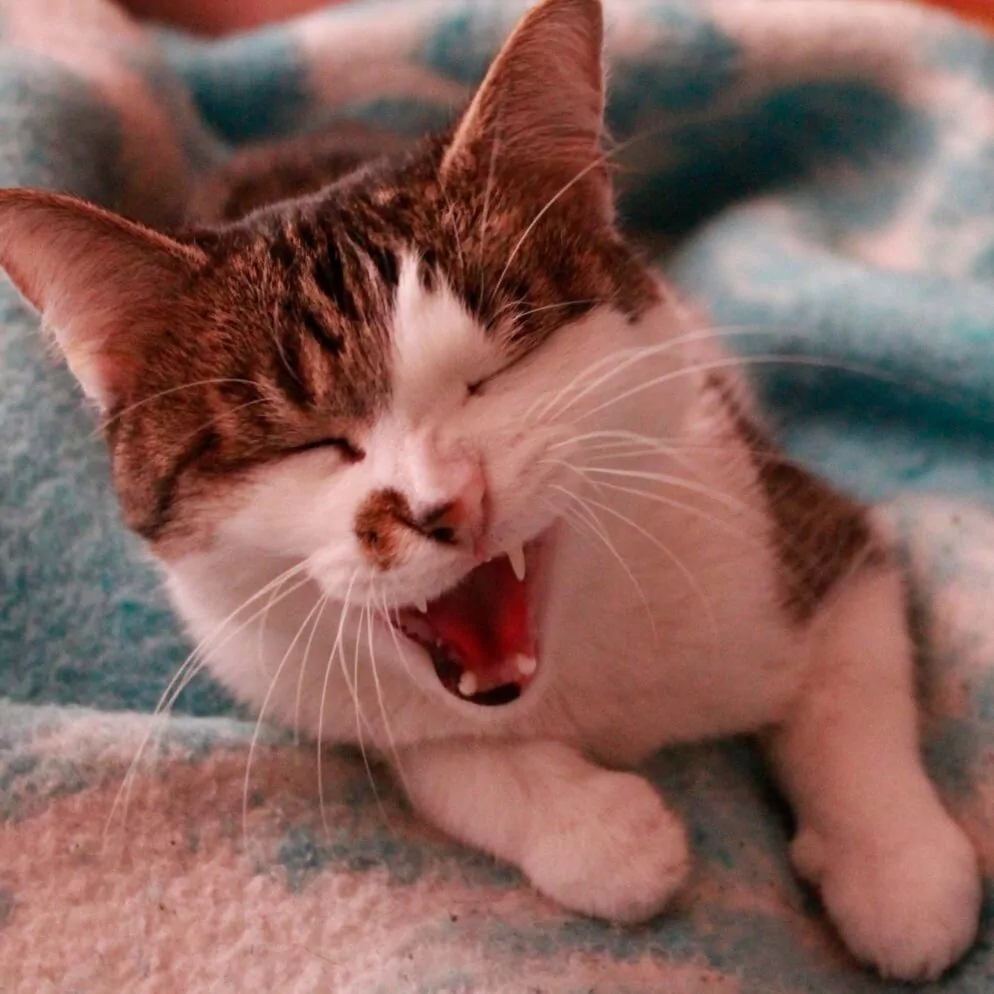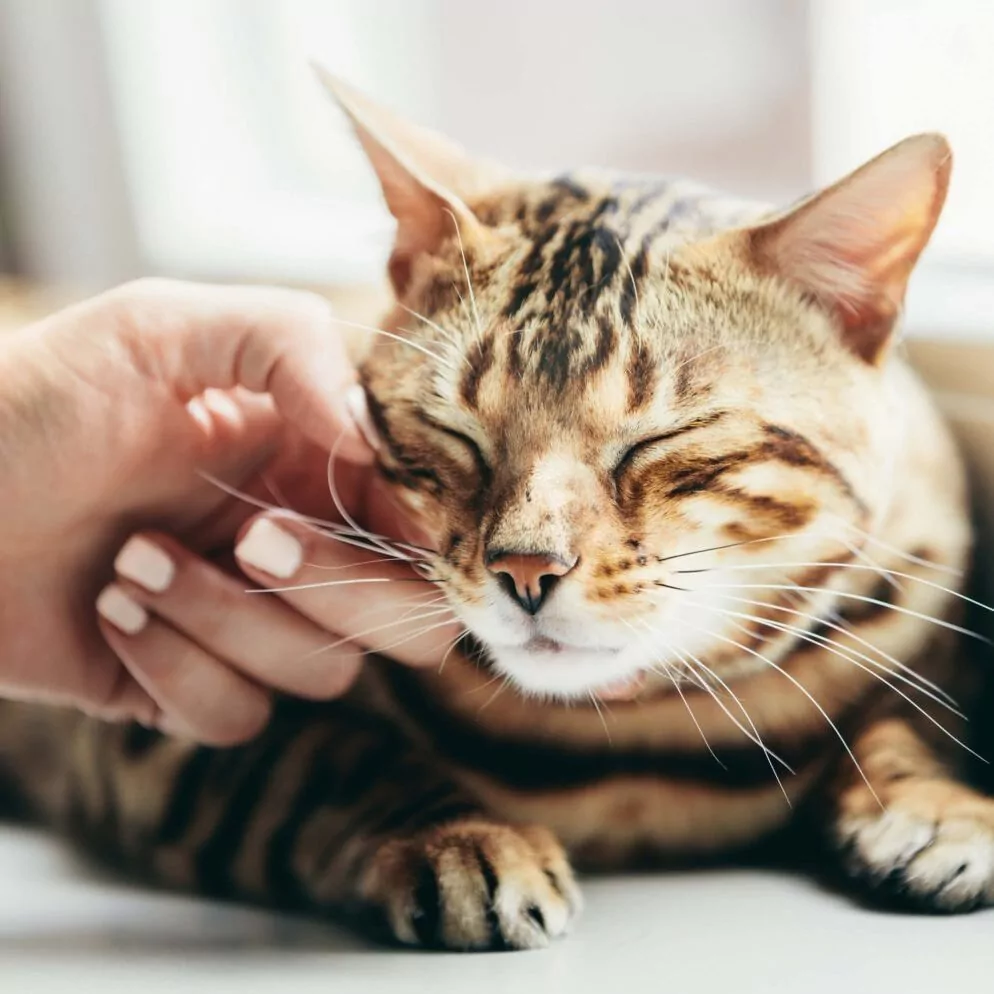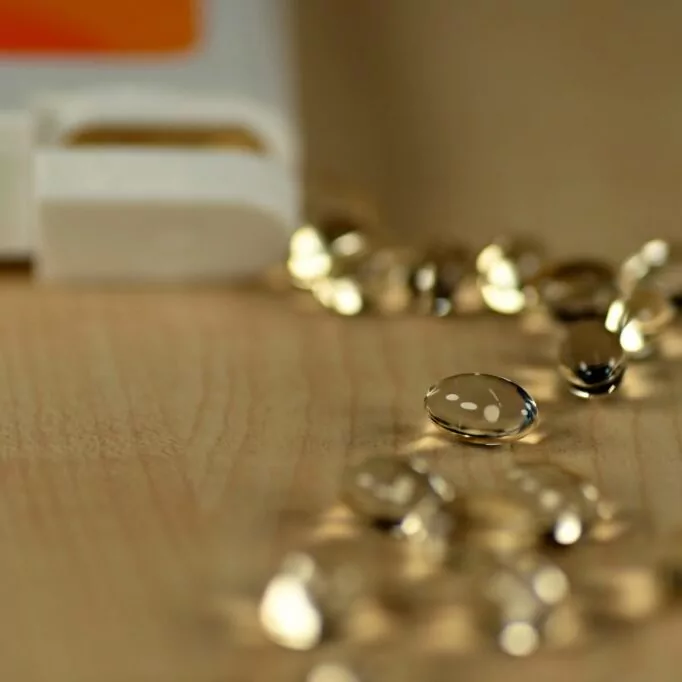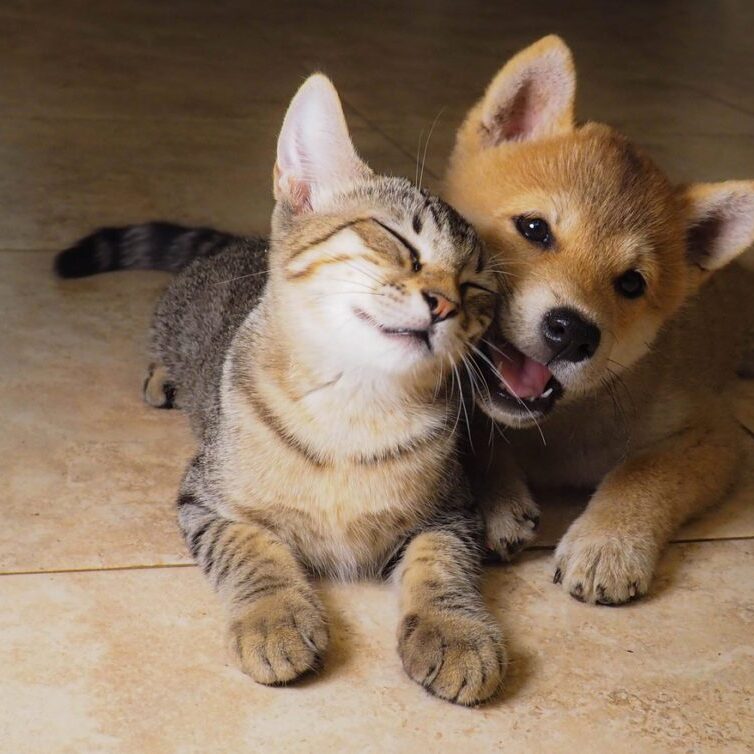Behavior & Symptoms
Cat Talk 101: How to Understand What Felines Are Saying

It’s 8:26 a.m. There is movement on the bed and a very polite “meow” accompanied by a gentle prod with a paw.
“Are you awake?” Ziggy, my feline alarm clock, has arrived.
No response brings a couple more “meows” and some more insistent prodding. Next, he walks above my head across the pillow and rattles the lampshade. He knows this gets a response.
I sit up. He’s ahead of the game and rushes off to wait for me in the bathroom.
“MIAU!” It’s louder. HURRY UP! Breakfast please.
“I’m coming,” I promise.
He heads off leading the way downstairs to the kitchen, followed by Tory, our dainty tuxedo cat.
“Mmeeeyowww.” Follow me, he commands.
He immediately jumps onto the counter to show me where the food is kept.
Meeyow meeyow! – Louder and insistent. Hurry up already. I’m hungry….
All this while Tory is waiting patiently, letting Ziggy speak for her.
I put down his bowl and Ziggy rushes over and tucks in.
I put down Tory’s bowl. “Mieu,” she says, her distinctive tiny voice accompanied by a gentle head bump on my hand. Thank you!
She eats a few bits and comes around to where I am making coffee.
“Mieu?” She is looking up at me with her tail in a question mark. Can we play? She’s worked out that while Ziggy is eating, it’s a great opportunity to solicit some alone time to play.
She immediately swings around and rushes to the stairs where she flops over and waits for me to grab a wand toy and play games. “Mprrh “– she repeats this gentle trilling sound as I engage with her and she bats the toy around, pouncing and playing.
“Enough now,” I say. “I need coffee.” She plays on her own for a bit and then heads off to the litter box before resuming her breakfast, followed by a thorough paw wash.
This is how every day starts. These are daily conversations with Ziggy and Tory.
Every Cat Has a Secret Language
“Every cat develops, in the course of the life they share with their humans, unique sounds that suit specific relationships and needs for communication,” explains Susanne Schötz, professor of phonetics (the study of human speech) at Lund University in Sweden. “It’s highly likely that the cat has identified sounds that will trigger expected results from their humans or fellow cats more quickly. Every cat has its own ‘secret’ language, known only to its trusted human – and even then, only if that human listens closely enough,” she adds.
And she should know. Schötz has written a book on the topic titled The Secret Language of Cats and oversees a research project at the university called Melody in Human-Cat Communication (Meowsic) in which she summarizes the various kinds of sounds, the situations in which they occur, and the existing variations.
Schötz and her husband Lars share their home with six cats: Donna, Rocky, Turbo, Vimsan, Kompis, and Greywhite. Their personalities and daily conversations are well documented in Schötz’s book and it makes for fascinating reading, simultaneously giving pet parents an opportunity to relate to the phonetic sounds that the author highlights with regard to their own felines. After years of research, Schötz admits there is still a bit of mystery, “But that’s exactly why we find cats so fascinating,” she adds.
Keep Talking
“I have also found that the more I talk to a cat, the more it talks back to me,” she says. But do all cats speak the same “language?” Schötz believes there are some geographic, cultural, and breed-based differences and suggests that cats may even be influenced by the language and accents spoken in their home.
Do cats have dialects too or do they develop a set of unique sounds that only their humans can understand?
“I still remember how I first noticed that my cats meowed differently when they were asking for food at home and when they were in the carrier and on the way to the vet,” she says. “The melody as well as the vowels sounded completely different.”
The study of cat sounds is not new; it is well documented that Charles Darwin recognized and wrote about different feline vocalizations and was particularly interested in ways that cats purr. And in 1944, Mildred Moelk published what is believed to be the first phonetic study of cat sounds.
“While the differences between human speech and animal sounds are well known,” says Schötz. “It’s the discovery of the similarities that’s especially interesting to me as a linguist. The organs cats use to produce sounds are smaller than ours, but they are similar. Both humans and cats have larynxes, tongues, palates, lips, and jaws. Cats move them in much the same way we do to produce their sounds. That is why we can also study the sound of cats using phonetic methods.”
Cats of course are well known for boosting their talkative skills with distinct body language signs such as head-bumping and rubbing against their favorite people, blinking their eyes to send kitty kisses, and yawning.
Meow – The Most Popular “Word” in Cat Language
While “meow” is the most common sound cats use to address humans, Schötz points out that it can be made with different vowels: [iu], [iau] [uæ]. With an “m” – miau and without – “au.”
She adds that cats sometimes meow in two or more syllables such as “wu-au” or “mia-wau.”
Female cats, who have smaller vocal organs, often have brighter meows than tom cats, while kittens meow even more brightly.
“As a rule, meows are produced with an opening-closing mouth. This is how the typical meow sound is produced or articulated. The ‘m’ is produced with a closed mouth, the mouth then opens for the ‘e’ and stays open for the ‘a’ before closing for the ‘w.’ Try meowing yourself,” she suggests. “And look in the mirror while you do it.”
Different sounds add different meanings, so a meow can be assertive, coaxing, demanding, inviting, imperious, whining, melancholic, suffering, friendly, or undaunted.
- It is often used to get attention – I want something!
- Or a declaration – My bowl is empty!
- Or a friendly greeting – I see you are there; I am here.
How Do Cats Say Meow? Let’s Count the Ways
One of Schötz’s first big discoveries was that the frequency range in cat sounds was enormous. Another was that felines use a large number of different sounds to communicate with humans and other cats.
The Mew: A very high-pitched sound often used by kittens to get their mother’s help and attention and used by adult cats seeking help and attention from humans.
The Squeak: A raspy, nasal, high-pitched, and often short mew-like call that is considered a friendly request for attention.
The Moan: A somewhat dark, low, resounding meow often used by a cat who is anxious, stressed, or demanding something.
The Trill: A short and soft sound that Schötz describes as somewhere between a purr and a meow. It’s a friendly approach and greeting and is often used during play. It can also be an acknowledgement.
The Extended Cat “Vocabulary”
Chirrups, Grunts, and Murmurs are all various phonetic versions of trill sounds.
The Trill-Meow: This is a combo of a trill and a meow sound, often with a rising tone.
The Howl: Often also categorized as a yowl, moan, or wail in anger. It’s a long and often repeated sequence of vowel sounds. Schötz describes it as a warning signal in aggressive and defensive situations and it is often merged or combined with a growl in long sequences of melody and loudness.
The Mating Call: This is a long sequence of meow-like sounds, trill meows, and howls produced by both male and female cats. It has been described as sounding a bit like a human child weeping and crying.
The Growl: This is a guttural, harsh, and very low-pitched and long sound used to signal danger and warn off an enemy.
The Hiss and the Spit: The hiss is a voiceless, noisy warning sound often produced with a raised upper lip, visible teeth, and an arched tongue. Spitting is a more explosive sound.
The Snarl: This is a loud, harsh and often high-pitched scream. It’s also described as a cry or shriek produced before a cat actively begins to fight. Consider it a final warning.
Come On, Let’s Prey…
Cats also have distinctive prey-directed sounds prompted by their innate hunting instinct.
The Chatter: This voiceless, rapid clicking sequence of sounds resembles teeth chattering. It is produced by the jaws juddering and is usually brought on when an insect or a bird or rodent catches the cat’s attention.
The Chirp: This is another prey-driven short call that sounds like the chirp of a bird. Some variations sound like bird tweeting noises accompanied by quivering jaws.
Various situations call for a variety of sounds, just like with humans. In her book, Schötz gives detailed phonetic transcriptions of all these sounds, and it is worth taking her “crash course” to become more familiar with them.
She says that her smartphone, with its camera and recording modes, has been an invaluable tool for recording the assortment of feline sounds in situ and has led to various specific research projects. Her first study was the phonetic characteristics of purring, the sound used to express contentment and happiness as well as to soothe pain. Then she focused on friendly cat sounds directed to humans as well as to other cats. Her third study homed in on chirping and chattering sounds. Then came the phonetic differences between happy and sad mellow sounds followed by an in-depth look at emotions and intonation in all cat sounds, such as joy, sorrow, anger, and desire. Next, Schötz focused on aggressive and defensive sounds.
She and her research colleagues are also looking at the melody within each sound category, naming the project Melody in Human-Cat Communication and coining the term Meowsic, a combo of meow and music. The goal of this research is to determine whether cats use different melodies when they are content, sad, dissatisfied, or angry and do they change the melody of their sounds in an attempt to be better understood by humans.
Schötz’s research is a work in progress. She encourages cat parents to listen closely to their cats and to even record them in order to break down their cat’s individual sounds linked to their unique behavior patterns. Her book is an excellent quick-study guide to a better understanding of feline communication skills. Check off your cat’s own communication aptitudes against the examples in her book and on the Meowsic website.
And keep talking to your cat!
Did you find this helpful? Share it!
Additional Information
1Only When It Feels Good: Specific Cat Vocalizations Other Than Meowing
Questions for your Vet
- Why is my cat howling in the middle of the night?
- Why do my cats hiss and fight with one another after one of my cats has recently been to the veterinarian?
- Is it true that a cat’s purr can help heal their injuries?
About VetScoop
Pets make our lives better. At VetScoop, we’re on a mission to return the favor by giving you access to trustworthy, science-based information so you can provide the best possible care for your pets.
Related Articles We Think You'd Like





